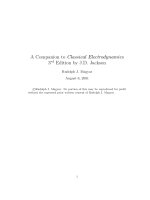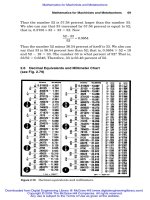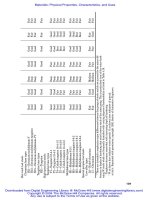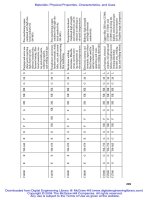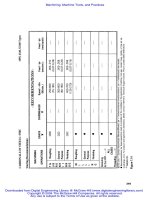Nerve and muscle 3rd ed r keynes, d aidley (cambridge, 2001)
Bạn đang xem bản rút gọn của tài liệu. Xem và tải ngay bản đầy đủ của tài liệu tại đây (9.57 MB, 193 trang )
This page intentionally left blank
Nerve and Muscle
Nerve and Muscle is an introductory textbook for students taking university courses in
physiology, cell biology or preclinical medicine. Previous editions were highly
acclaimed as a readable and concise account of how nerves and muscles work. The
book begins with a discussion of the nature of nerve impulses. These electrical
events can be understood in terms of the flow of ions through molecular channels
in the nerve cell membrane. Then the view changes to consideration of synaptic
transmission: how one nerve cell can produce changes in another nerve cell or a
muscle fibre with which it makes contact. Again ion channels are involved, but now
they are opened by special chemicals released from the nerve cell terminals. The
final chapters discuss the nature of muscular contraction, including especially the
relations between cellular structure and contractile function. This new edition
includes much new material, especially on the molecular nature of ion channels and
the contractile mechanism of muscle, while retaining a straightforward exposition
of the fundamentals of the subject.
The Studies in Biology series is published in association with the Institute of
Biology (London, UK). The series provides short, affordable and very readable
textbooks aimed primarily at undergraduate biology students. Each book offers
either an introduction to a broad area of biology (e.g. Introductory Microbiology), or a
more in-depth treatment of a particular system or specific topic (e.g. Photosynthesis).
All of the subjects and systems covered are selected on the basis that all
undergraduate students will study them at some point during their biology degree
courses.
Titles available in this series
An Introduction to Genetic Engineering, D. S. T. Nicholl
Introductory Microbiology, J. Heritage, E. G. V. Evans and R. A. Killington
Biotechnology, 3rd edition, J. E. Smith
An Introduction to Parasitology, B. E. Matthews
Photosynthesis, 6th edition, D. O. Hall and K. K. Rao
Microbiology in Action, J. Heritage, E. G. V. Evans and R. A. Killington
Essentials of Animal Behaviour, P. J. B. Slater
An Introduction to the Invertebrates, J. Moore
Nerve and muscle
Third Edition
R. D. Keynes
Emeritus Professor of Physiology in the
University of Cambridge and
Fellow of Churchill College
and
D. J. Aidley
Senior Fellow, Biological Sciences
University of East Anglia, Norwich
Cambridge, New York, Melbourne, Madrid, Cape Town, Singapore, São Paulo
Cambridge University Press
The Edinburgh Building, Cambridge , United Kingdom
Published in the United States of America by Cambridge University Press, New York
www.cambridge.org
Information on this title: www.cambridge.org/9780521801720
© Cambridge University Press, 1981, 1991, 2001
This book is in copyright. Subject to statutory exception and to the provision of
relevant collective licensing agreements, no reproduction of any part may take place
without the written permission of Cambridge University Press.
First published in print format 2001
-
isbn-13 978-0-511-06337-4 eBook (NetLibrary)
-
isbn-10 0-511-06337-7 eBook (NetLibrary)
-
isbn-13 978-0-521-80172-0 hardback
-
isbn-10 0-521-80172-9 hardback
-
isbn-13 978-0-521-80584-1 paperback
-
isbn-10 0-521-80584-8 paperback
Cambridge University Press has no responsibility for the persistence or accuracy of
s for external or third-party internet websites referred to in this book, and does not
guarantee that any content on such websites is, or will remain, accurate or appropriate.
Contents
Preface
page xi
11 Structural organization of the nervous system
Nervous systems
The anatomy of a neuron
Non-myelinated nerve fibres
Myelinated nerve fibres
1
1
2
3
6
12 Resting and action potentials
Electrophysiological recording methods
Intracellular recording of the membrane potential
Extracellular recording of the nervous impulse
Excitation
11
11
13
15
19
13 The ionic permeability of the nerve membrane
Structure of the cell membrane
Distribution of ions in nerve and muscle
The genesis of the resting potential
The Donnan equilibrium system in muscle
The active transport of ions
25
25
28
31
33
34
14 Membrane permeability changes during excitation
The impedance change during the spike
The sodium hypothesis
41
41
41
viii Contents
Voltage-clamp experiments
Patch-clamp studies
47
57
15 Voltage-gated ion channels
cDNA sequencing studies
The primary structure of voltage-gated ion channels
The sodium gating current
The screw-helical mechanism of voltage-gating
The ionic selectivity of voltage-gated channels
59
59
61
64
66
69
16 Cable theory and saltatory conduction
The spread of potential changes in a cable system
Saltatory conduction in myelinated nerves
Factors affecting conduction velocity
Factors affecting the threshold for excitation
After-potentials
73
73
75
81
82
84
17 Neuromuscular transmission
The neuromuscular junction
Chemical transmission
Postsynaptic responses
Presynaptic events
86
86
87
89
99
18 Synaptic transmission in the nervous system
Synaptic excitation in motoneurons
Inhibition in motoneurons
Slow synaptic potentials
Electrotonic synapses
103
104
107
110
115
19 Skeletal muscles
Anatomy
Mechanical properties
Energetics of contraction
Muscular exercise
118
118
120
127
132
10 The mechanism of contraction in skeletal muscle
Excitation–contraction coupling
The structure of the myofibril
The sliding filament theory
The molecular basis of contraction
136
136
143
146
149
Contents ix
11 Non-skeletal muscles
Cardiac muscle
Smooth muscle
Further reading
References
Index
156
156
164
168
169
175
Preface
People are judged by their actions, and these actions are coordinated by nerve
cells and carried out by muscle cells. So an understanding of nerve and muscle
is fundamental to our knowledge of how the human body functions.
This book provides an introductory account of how nerve and muscle cells
work, suitable for students taking university courses in physiology, cell biology
or preclinical medicine. It aims to give a straightforward exposition of the fundamentals of the subject, including particularly some of the experimental evidence upon which our conclusions are based. This edition includes new
material reflecting the exciting discoveries that continue to be made in the
field. So there is up-to-date detail on topics such as the ion channels involved
in electrical activity and the molecular mechanisms of muscular contraction.
R. D. Keynes
D. J. Aidley
Publishers note
Dr David Aidley died suddenly but peacefully at home on August 24th 2000.
David was a gifted teacher: generations of students at the University of
East Anglia benefited from his broad knowledge and relaxed style. A much
wider audience knew David through his books, which over a thirty-year period
have provided information, guidance and inspiration to students and their
teachers in many parts of the world. The Physiology of Excitable Cells was first
published in 1971 and is currently available in a fourth edition. Nerve and Muscle
(with Richard Keynes) first appeared in 1981 and the third edition was to
appear in proof the week he died. Ion Channels: molecules in action (with Peter
Stanfield) was published in 1996. Each book represents an exemplary example
of lucid prose and a clear grasp of the subject matter.
David was the perfect author; his books were delivered on time, in good
order and each found a ready audience. He was, for these and many other
reasons, a delight to work with, and we join his many friends in lamenting his
untimely death and extending our condolences to his wife Jessica and their
family.
1
Structural organization of the
nervous system
Nervous systems
One of the characteristics of higher animals is their possession of a more or
less elaborate system for the rapid transfer of information through the body
in the form of electrical signals, or nervous impulses. At the bottom of the
evolutionary scale, the nervous system of some primitive invertebrates consists simply of an interconnected network of undifferentiated nerve cells. The
next step in complexity is the division of the system into sensory nerves responsible for gathering incoming information, and motor nerves responsible for
bringing about an appropriate response. The nerve cell bodies are grouped
together to form ganglia. Specialized receptor organs are developed to detect
every kind of change in the external and internal environment; and likewise
there are various types of effector organ formed by muscles and glands, to
which the outgoing instructions are channelled. In invertebrates, the ganglia
which serve to link the inputs and outputs remain to some extent anatomically
separate, but in vertebrates the bulk of the nerve cell bodies are collected
together in the central nervous system. The peripheral nervous system thus consists of
afferent sensory nerves conveying information to the central nervous system,
and efferent motor nerves conveying instructions from it. Within the central
nervous system, the different pathways are connected up by large numbers of
interneurons which have an integrative function.
Certain ganglia involved in internal homeostasis remain outside the central
nervous system. Together with the preganglionic nerve trunks leading to them,
and the postganglionic fibres arising from them which innervate smooth
muscle and gland cells in the animal’s viscera and elsewhere, they constitute the
2 Structural organization of the nervous system
Fig. 1.1. Schematic diagrams (not to scale) of the structure of: a, a spinal
motoneuron; b, a spinal sensory neuron; c, a pyramidal cell from the motor cortex
of the brain; d, a bipolar neuron in the vertebrate retina.
autonomic nervous system. The preganglionic autonomic fibres leave the central
nervous system in two distinct outflows. Those in the cranial and sacral nerves
form the parasympathetic division of the autonomic system, while those coming
from the thoracic and lumbar segments of the spinal cord form the sympathetic
division.
The anatomy of a neuron
Each neuron has a cell body in which its nucleus is located, and a number of
processes or dendrites (Fig. 1.1). One process, usually much longer than the rest,
is the axon or nerve fibre which carries the outgoing impulses. The incoming
Non-myelinated nerve fibres 3
signals from other neurons are passed on at junctional regions known as
synapses scattered over the cell body and dendrites, but discussion of their
structure and of the special mechanisms involved in synaptic transmission will
be deferred to Chapter 7. At this stage we are concerned only with the properties of peripheral nerves, and need not concern ourselves further with the
cell body, for although its intactness is essential in the long term to maintain
the axon in working order, it does not actually play a direct role in the conduction of impulses. A nerve can continue to function for quite a while after
being severed from its cell body, and electrophysiologists would have a hard
time if this were not the case.
Non-myelinated nerve fibres
Vertebrates have two main types of nerve fibre, the larger fast-conducting
axons, 1 to 25 m in diameter, being myelinated, and the small slowly conducting ones (under 1 m) being non-myelinated. Most of the fibres of the autonomic system are non-myelinated, as are peripheral sensory fibres subserving
sensations like pain and temperature where a rapid response is not required.
Almost all invertebrates are equipped exclusively with non-myelinated fibres,
but where rapid conduction is called for, their diameter may be as much as 500
or even 1000 m. As will be seen in subsequent chapters, the giant axons of
invertebrates have been extensively exploited in experiments on the mechanism of conduction of the nervous impulse. The major advances made in
electrophysiology during the last fifty years have very often depended heavily
on the technical possibilities opened up by the size of the squid giant axon.
All nerve fibres consist essentially of a long cylinder of cytoplasm, the axoplasm, surrounded by an electrically excitable nerve membrane. Now the electrical resistance of the axoplasm is fairly low, by virtue of the Kϩ and other ions
that are present in appreciable concentrations, while that of the membrane is
relatively high; and the salt-containing body fluids outside the membrane are
again good conductors of electricity. Nerve fibres therefore have a structure
analogous to that of a shielded electric cable, with a central conducting core
surrounded by insulation, outside which is another conducting layer. Many
features of the behaviour of nerve fibres depend intimately on their cable structure.
The layer analogous with the insulation of the cable does not, however,
consist solely of the high-resistance nerve membrane, owing to the presence
of Schwann cells, which are wrapped around the axis cylinder in a manner which
varies in the different types of nerve fibre. In the case of the olfactory nerve
4 Structural organization of the nervous system
Fig. 1.2. Electron micrograph of a section through the olfactory nerve of a pike,
showing a bundle of non-myelinated nerve fibres partially separated from other
bundles by the basement membrane B. The mean diameter of the fibres is 0.2 m,
except where they are swollen by the presence of a mitochondrion (M). Reproduced
by courtesy of Prof. E. Weibel. Magnification 54 800 ϫ.
(Fig. 1.2), a single Schwann cell serves as a multi-channel supporting structure
enveloping a short stretch of thirty or more tiny axons. Elsewhere, each axon
may be more or less closely associated with a Schwann cell of its own, some
being deeply embedded within the Schwann cell, and others almost uncovered. In general, as in the example shown in Fig. 1.3, each Schwann cell
Non-myelinated nerve fibres 5
Fig. 1.3. Electron micrograph of a cross-section through a mammalian nerve
showing non-myelinated fibres with their supporting Schwann cells and some small
myelinated fibres. Reproduced by courtesy of Professor J. D. Robertson.
supports a small group of up to half a dozen axons. In the large invertebrate
axons (Fig. 1.4) the ratio is reversed, the whole surface of the axon being
covered with a mosaic of many Schwann cells interdigitated with one another
to form a layer several cells thick. In all non-myelinated nerves, both large and
small, the axon membrane is separated from the Schwann cell membrane by
a space about 10 nm wide, sometimes referred to by anatomists as the mesaxon.
This space is in free communication with the main extracellular space of the
tissue, and provides a relatively uniform pathway for the electric currents
which flow during the passage of an impulse. However, it is a pathway that
can be quite tortuous, so that ions which move out through the axon membrane in the course of an impulse are prevented from mixing quickly with
extracellular ions, and may temporarily pile up outside, thus contributing to
the after-potential (see p. 84). Nevertheless, for the immediate purpose of
describing the way in which nerve impulses are propagated, non-myelinated
fibres may be regarded as having a uniformly low external electrical resistance
between different points on the outside of the membrane.
6 Structural organization of the nervous system
Fig. 1.4. Electron micrograph of the surface of a squid giant axon, showing the
axoplasm (A), Schwann cell layer (SC), and connective tissue sheath (CT). Ions
crossing the excitable membrane (M, arrowheads) must diffuse laterally to the
junction between neighbouring Schwann cells marked with an arrow, and thence
along the gap between the cells into the external medium. Magnification 22 600 ϫ.
Reproduced by courtesy of Dr F. B. P. Wooding.
Myelinated nerve fibres
In the myelinated nerve fibres of vertebrates, the excitable membrane is insulated electrically by the presence of the myelin sheath everywhere except at the
node of Ranvier (Figs. 1.5, 1.6, 1.7). In the case of peripheral nerves, each stretch
of myelin is laid down by a Schwann cell that repeatedly envelops the axis
cylinder with many concentric layers of cell membrane (Fig. 1.7); in the central
nervous system, it is the cells known as oligodendroglia that lay down the myelin.
All cell membranes consist of a double layer of lipid molecules with which
some proteins are associated (see p. 26), forming a structure that after appropriate staining appears under the electron microscope as a pair of dark lines
2.5 nm across, separated by a 2.5 nm gap. In an adult myelinated fibre, the adjacent layers of Schwann cell membrane are partly fused together at their
Myelinated nerve fibres 7
Fig. 1.5. Electron micrograph of a node of Ranvier in a single fibre dissected from
a frog nerve. Reproduced by courtesy of Professor R. Stämpfli.
cytoplasmic surface, and the overall repeat distance of the double membrane
as determined by X-ray diffraction is 17 nm. For a nerve fibre whose outside
diameter is 10 m, each stretch of myelin is about 1000 m long and 1.3 m
thick, so that the myelin is built up of some 75 double layers of Schwann cell
membrane. In larger fibres, the internodal distance, the thickness of the
myelin and hence the number of layers, are all proportionately greater. Since
myelin has a much higher lipid content than cytoplasm, it also has a greater
refractive index, and in unstained preparations has a characteristic glistening
white appearance. This accounts for the name given to the peripheral white
matter of the spinal cord, consisting of columns of myelinated nerve fibres, as
contrasted with the central core of grey matter, which is mainly nerve cell bodies
8 Structural organization of the nervous system
Fig. 1.6. Schematic diagram of the structure of a vertebrate myelinated nerve
fibre. The distance between neighbouring nodes is actually about 40 times greater
relative to the fibre diameter than is shown here.
and supporting tissue. It also accounts for the difference between the white
and grey rami of the autonomic system, containing respectively small myelinated nerve fibres and non-myelinated fibres.
At the node of Ranvier, the closely packed layers of Schwann cell terminate on either side as a series of small tongues of cytoplasm (Fig. 1.7), leaving
a gap about 1 m in width where there is no obstacle between the axon membrane and the extra-cellular fluid. The external electrical resistance between
neighbouring nodes of Ranvier is therefore relatively low, whereas the resistance between any two points on the internodal stretch of membrane is high
because of the insulating effect of the myelin. The difference between the
nodes and internodes in accessibility to the external medium is the basis for
the saltatory mechanism of conduction in myelinated fibres (see p. 75), which
enables them to conduct impulses some 50 times faster than a non-myelinated
fibre of the same overall diameter. Nerves may branch many times before terminating, and the branches always arise at nodes.
In peripheral myelinated nerves the whole axon is usually described as
being covered by a thin, apparently structureless basement membrane, the
neurilemma. The nuclei of the Schwann cells are to be found just beneath the
neurilemma, at the midpoint of each internode. The fibrous connective
tissue which separates individual fibres is known as the endoneurium. The
fibres are bound together in bundles by the perineurium, and the several
Myelinated nerve fibres 9
Fig. 1.7. Drawing of a node of Ranvier made from an electron micrograph. The
axis cylinder A is continuous through the node; the axoplasm contains mitochondria
(M) and other organelles. The myelin sheath, laid down as shown below by
repeated envelopment of the axon by the Schwann cell on either side of the node,
is discontinuous, leaving a narrow gap X where the excitable membrane is
accessible to the outside. Small tongues of Schwann cell cytoplasm (S) project into
the gap but do not close it entirely. From Robertson (1960).
bundles which in turn form a whole nerve trunk are surrounded by the
epineurium. The connective tissue sheaths in which the bundles of nerve
fibres are wrapped also contain continuous sheets of cells which prevent
extracellular ions in the spaces between the fibres from mixing freely with
those outside the nerve trunk. The barrier to free diffusion offered by the
10 Structural organization of the nervous system
sheath is probably responsible for some of the experimental discrepancies
between the behaviour of fibres in an intact nerve and that of isolated single
nerve fibres. The nerve fibres within the brain and spinal cord are packed
together very closely, and are usually said to lack a neurilemma. The individual fibres are difficult to tease apart, and the nodes of Ranvier are less easily
demonstrated than in peripheral nerves by such histological techniques as
staining with silver nitrate.
2
Resting and action potentials
Electrophysiological recording methods
Although the nervous impulse is accompanied by effects that can under specially favourable conditions be detected with radioactive tracers, or by optical
and thermal techniques, electrical recording methods normally provide much
the most sensitive and convenient approach. A brief account is therefore necessary of some of the technical problems that arise in making good measurements both of steady electrical potentials and rapidly changing ones.
In order to record the potential difference between two points, electrodes
connected to a suitable amplifier and recording system must be placed at each
of them. If the investigation is only concerned with action potentials, fine
platinum or tungsten wires can serve as electrodes, but any bare metal surface
has the disadvantage of becoming polarized by the passage of electric current
into or out of the solution with which it is in contact. When, therefore, the
magnitude of the steady potential at the electrode tip is to be measured, nonpolarizable or reversible electrodes must be used, for which the unavoidable
contact potential between the metal and the solution is both small and constant.
The simplest type of reversible electrode is provided by coating a silver wire
electrolytically with silver chloride, but for the most accurate measurements
calomel (mercury/mercuric chloride) half-cells are best employed.
When the potential inside a cell is to be recorded, the electrode has to be
very well insulated except at its tip, and so fine that it can penetrate the cell
membrane with a minimum of damage and without giving rise to electrical
leaks. The earliest intracellular recordings were actually made by pushing a
glass capillary 50 m in diameter longitudinally down a 500 m squid axon
